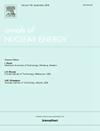Study of the optimal layout of U-bolt restraints used for High-Energy pipelines based on parametric modeling
IF 2.3
3区 工程技术
Q1 NUCLEAR SCIENCE & TECHNOLOGY
引用次数: 0
Abstract
The protective design of high-temperature, high-pressure pipelines is critical for nuclear safety. Current specifications underestimate the injection forces compared to those in actual engineering scenarios. There has been limited research on anti-whipping components for high-energy pipelines, especially those operating above 300 °C and 30.0 MPa. This study utilized a collaborative simulation scheme combining ANSYS APDL (Ansys Parametric Design Language) and LS-DYNA to optimize U-bolt restraints for high-energy pipelines. Parametric modelling of U-bolt restraints was performed in ANSYS APDL, while impact simulations were conducted in LS-DYNA. Sensitivity analysis showed that the U-bolt restraint number, diameter, and fixed leg length significantly affected the anti-whipping performance. An anti-whipping failure criterion based on the kinetic energy was proposed and used in the optimization process. The results suggest that arranging three U-bolts obliquely in the pipeline’s elbow improves the performance, and for a double-bend pipe, intact U-bolts prevent failure from oblique loads.
基于参数化建模的高能管道u型螺栓约束优化布置研究
高温高压管道的防护设计对核安全至关重要。与实际工程场景相比,目前的规范低估了注入力。目前,针对高能量管道,特别是300°C和30.0 MPa以上的管道,抗鞭挞组件的研究非常有限。本研究采用ANSYS APDL (ANSYS参数化设计语言)和LS-DYNA相结合的协同仿真方案,对高能管道u型螺栓约束进行优化。在ANSYS APDL中对u型螺栓约束进行参数化建模,在LS-DYNA中进行冲击仿真。灵敏度分析表明,u型螺栓约束数、直径和固定腿长对防鞭打性能有显著影响。提出了基于动能的抗鞭笞失效准则,并将其应用于优化过程中。结果表明,在管道弯头处斜布置3个u型螺栓可以提高管道性能,对于双弯头管道,完整的u型螺栓可以防止倾斜载荷破坏。
本文章由计算机程序翻译,如有差异,请以英文原文为准。
求助全文
约1分钟内获得全文
求助全文
来源期刊

Annals of Nuclear Energy
工程技术-核科学技术
CiteScore
4.30
自引率
21.10%
发文量
632
审稿时长
7.3 months
期刊介绍:
Annals of Nuclear Energy provides an international medium for the communication of original research, ideas and developments in all areas of the field of nuclear energy science and technology. Its scope embraces nuclear fuel reserves, fuel cycles and cost, materials, processing, system and component technology (fission only), design and optimization, direct conversion of nuclear energy sources, environmental control, reactor physics, heat transfer and fluid dynamics, structural analysis, fuel management, future developments, nuclear fuel and safety, nuclear aerosol, neutron physics, computer technology (both software and hardware), risk assessment, radioactive waste disposal and reactor thermal hydraulics. Papers submitted to Annals need to demonstrate a clear link to nuclear power generation/nuclear engineering. Papers which deal with pure nuclear physics, pure health physics, imaging, or attenuation and shielding properties of concretes and various geological materials are not within the scope of the journal. Also, papers that deal with policy or economics are not within the scope of the journal.
 求助内容:
求助内容: 应助结果提醒方式:
应助结果提醒方式:


